知识图谱选哪些方向好发论文?附60+篇经典论文合集
7本电子书免费领,60+经典论文PDF免费领,见文末。
22年Q1大厂面试题出来了,可秒,也可私我或任意一位老师免费领
导读:
知识图谱的概念是Google于2012年正式提出,但是知识图谱的发展却可以追溯到1960年的语义网络。
1984, Douglas Lenat设立的Cyc是本体知识库。
1989, Tim Berners-Lee发明了万维网。
1998, Tim Berners-Lee再次提出语义网,语义网是能够根据语义进行判断的智能网络,实现人与电脑之间的无障碍沟通。它好比一个巨型的大脑,智能化程度极高,协调能力非常强大。
2006, Tim Berners-Lee提出链接数据(Linked Data)的概念,数据不仅仅发布于语义网中,而要建立起数据之间的链接从而形成一张巨大的链接数据网。
2007, DBpedia项目是目前已知的第一个大规模开放域链接数据。
2012, Google提出了知识图谱的概念。
知识图谱大体可以分为三个方向,分别为知识表示、知识获取和知识应用,也有把时序知识单独分成一类的。

而在不同的方向中,又有很多细分的方向,如知识表示建模、实体识别、实体链接、关系抽取、事件抽取、信息抽取、知识表示、知识融合、知识推理、知识图谱嵌入等等。
▋由于方向很多,想发表知识图谱相关的论文常常无从下手,那么知识图谱现在选择哪个方向好发论文呢?
近期随着深度学习模型的发展,特别是基于Bert的预训练模型的发展,知识作为先验信息在自然语言理解中起着重要的作用,将知识图谱通过某种方式融入到预训练模型中,进而可以获得效果上的提升。
在预训练模型上引入知识的工作如ERNIE,K-BERT,KEPLER等,通过在已有模型中加入entity embedding输入或者objective function约束来引入知识。
虽然知识图谱的相关技术发展很快,但在自然语言处理、人工智能 等领域展现巨大潜力的同时,知识图谱在知识获取、知识表示、知识推理等技术依然面临着一些困难与挑战,很多重要的开放问题急待学术界与工业界协力来解决。
相应也会有一些研究热点,如:
1️⃣以马尔可夫逻辑网、本体推理的联合推理方法;
2️⃣知识图谱与预训练模型的融合;
3️⃣跨语言的知识抽取方法;
4️⃣基于实体的、关系的、Web文本的、多知识库的融合方法;
5️⃣多模态知识图谱技术;
6️⃣图神经网络进行知识嵌入;
7️⃣强化学习与知识图谱的结合使用(图谱推理、实体对齐);
8️⃣增量更新技术在知识图谱上的应用等等。
以上研究热点均可作为尝试发表论文的方向(tips:文末有参考论文)。

对于发论文没有想法的同学可以参考以上热点进行创作,如果到这个节点还是无法解决论文问题的同学,建议大家可以参加一下七月在线的【AI学术论文一对一发表辅导】,
一对一管家式服务,全程辅导,围绕“国内期刊、EI会议/ei期刊、SCI四区到SCl一区/CCF ABC三类、AI各顶会”做全程辅导,包括且不限于课题确定、创作、修改、投递、发布等等,从而在导师辅导下学员独立自主创作至成功发表;
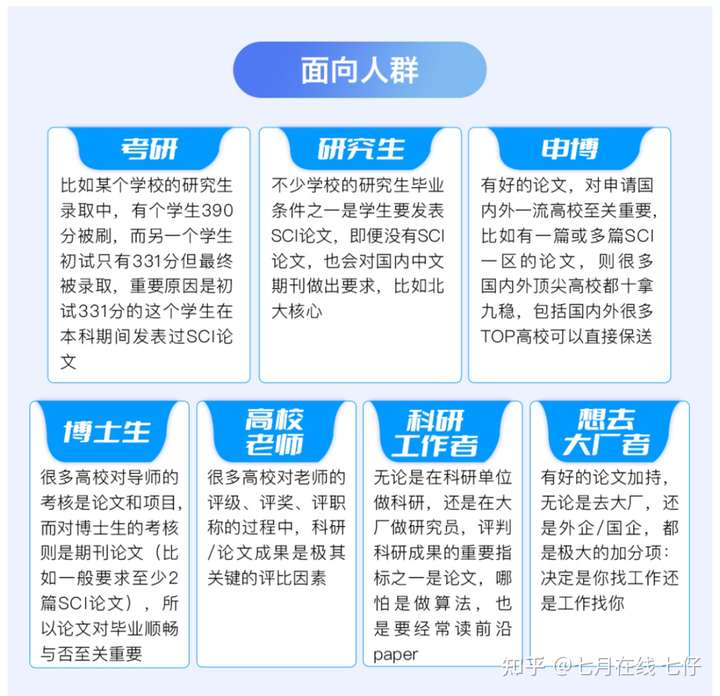
且老师都是国内外知名高校博士毕业且具备强大学术背景的师资团队,针对不同群体不同的诉求提供整体解决方案。
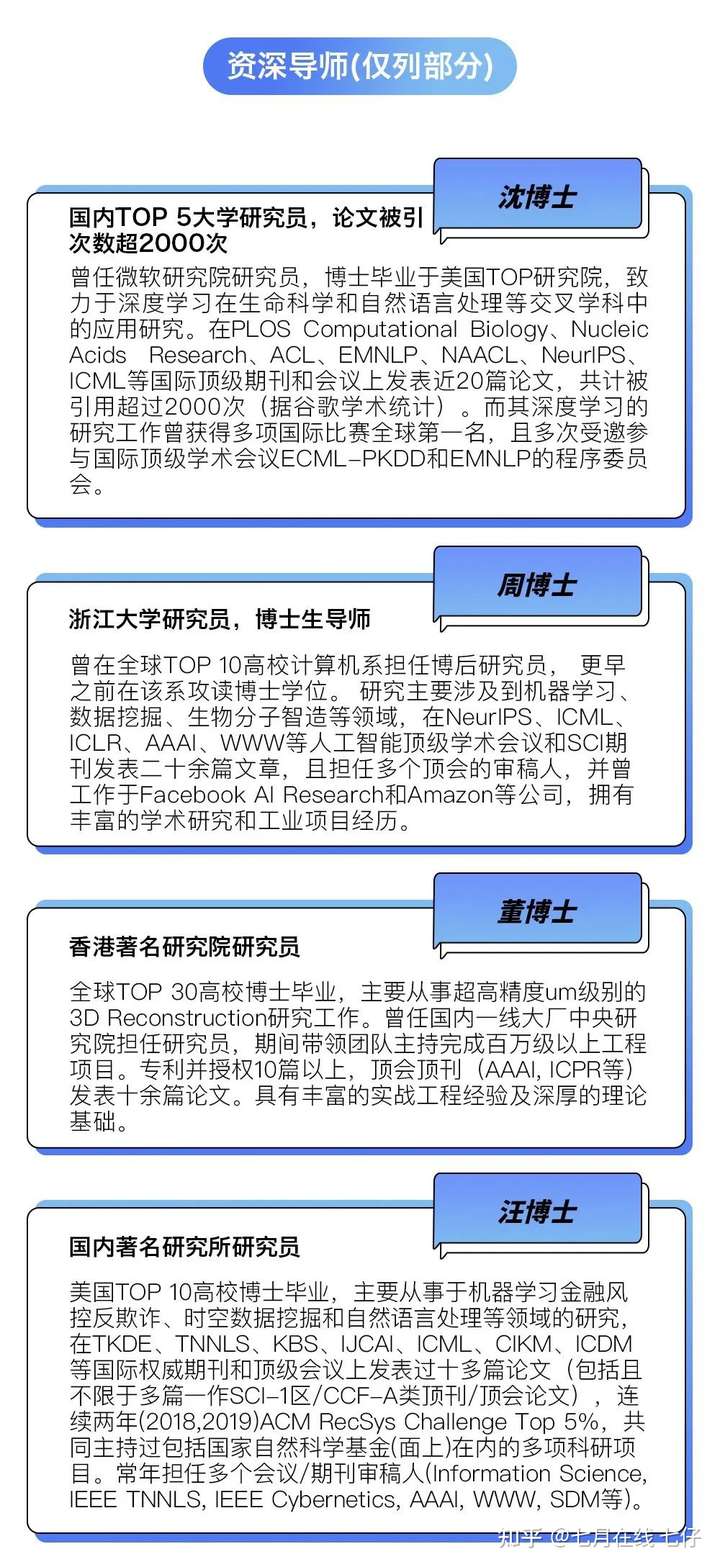

同时在学员在发表第一篇的过程中,让学员掌握—套成体系的论文发表方法/策略/流程,为后续成为会议/paper收割机打下坚实基础。
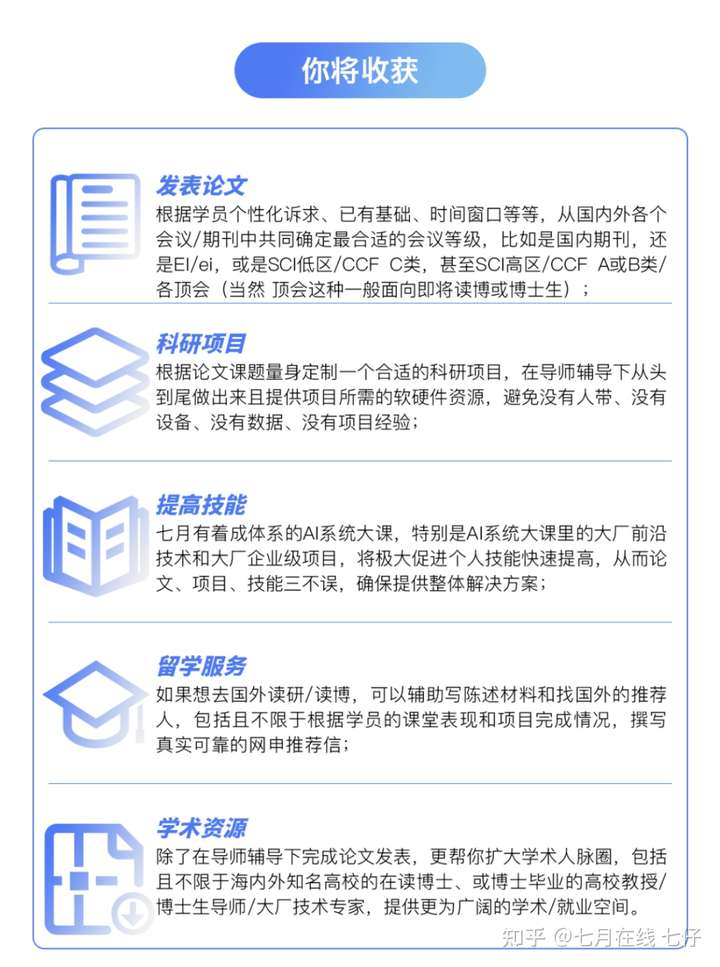
目前,大规模知识图谱的应用场景和方式还比较有限,其在智能搜索、深度问答、社交网络以及其他行业中的使用也只是处于初级阶段,仍具有广阔的可扩展空间。
在挖掘需求、探索知识图谱的应用场景时,应充分考虑知识图谱的以下优势:
1) 对海量、异构、动态的半结构化、非结构化数据的有效组织与表达能力;
2) 依托于强大知识库的深度知识推理能力;
3) 与深度学习、类脑科学等领域 相结合,逐步扩展的认知能力。
在对知识图谱技术有丰富积累的基础上,敏锐的感知人们的需求,结合具体的业务,可为大规模知识图谱的应用找到更宽广、更合适的应用之道。
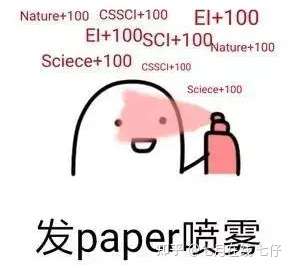
下面给出知识图谱一些方向的论文参考:
01 知识图谱构建
► Dong X, Gabrilovich E, Heitz G, et al. Knowledge vault: A web-scale approach to probabilistic knowledge fusion. KDD2014: 601-610.
► Suchanek F M, Kasneci G, Weikum G. Yago: a core of semantic knowledge. WWW2007: 697-706.
► Hoffart J, Suchanek F M, Berberich K, et al. YAGO2: A spatially and temporally enhanced knowledge base from Wikipedia. Artificial Intelligence, 2013, 194: 28-61.
02 关系抽取
► Liu C Y, Sun W B, Chao W H, et al. Convolution neural network for relation extraction[C]//International Conference on Advanced Data Mining and Applications. Springer, Berlin, Heidelberg, 2013: 231-242.
► Zeng D, Liu K, Lai S, et al. Relation classification via convolutional deep neural network[J]. 2014.
► Santos, Cicero Nogueira dos, Bing Xiang, and Bowen Zhou. “Classifying relations by ranking with convolutional neural networks.” In Proceedings of ACL, 2015.
03 事件抽取
► Chen Y, Xu L, Liu K, et al. Event extraction via dynamic multi-pooling convolutional neural networks. ACL2015, 1: 167-176.
► Nguyen T H, Grishman R. Event detection and domain adaptation with convolutional neural networks. ACL2015, 2: 365-371.
► Narasimhan K, Yala A, Barzilay R. Improving information extraction by acquiring external evidence with reinforcement learning. EMNLP2016.
► Nguyen T H, Cho K, Grishman R. Joint event extraction via recurrent neural networks. NAACL2016: 300-309.
04 知识融合
► Papadakis G, Ioannou E, Palpanas T, et al. A blocking framework for entity resolution in highly heterogeneous information spaces. IEEE Transactions on Knowledge and Data Engineering, 2013, 25(12): 2665-2682.
► Zhang Y, Zhang F, Yao P, et al. Name Disambiguation in AMiner: Clustering, Maintenance, and Human in the Loop. KDD2018: 1002-1011.
► Ngomo A C N, Auer S. LIMES—a time-efficient approach for large-scale link discovery on the web of data. IJCAI2011.
05 知识图谱嵌入
► Yang B, Yih W, He X, et al. Embedding entities and relations for learning and inference in knowledge bases. arXiv preprint arXiv:1412.6575, 2014. (DistMult)
► Nickel M, Rosasco L, Poggio T. Holographic embeddings of knowledge graphs. AAAI. 2016. (HolE)
► Trouillon T, Welbl J, Riedel S, et al. Complex embeddings for simple link prediction. International Conference on Machine Learning. 2016: 2071-2080. (ComplEx)
► Liu H, Wu Y, Yang Y. Analogical inference for multi-relational embeddings. Proceedings of the 34th International Conference on Machine Learning-Volume 70. JMLR. org, 2017: 2168-2178. (ANALOGY)
06 知识推理/知识挖掘
► PTransE: Sun M , Zhu H , Xie R , et al. Iterative Entity Alignment via Joint Knowledge Embeddings[C]// International Joint Conference on Artificial Intelligence. AAAI Press, 2017.
► Shen Y , Huang P S , Chang M W , et al. Modeling Large-Scale Structured Relationships with Shared Memory for Knowledge Base Completion[J]. 2016.
► Graves A , Wayne G , Reynolds M , et al. Hybrid computing using a neural network with dynamic external memory[J]. Nature.
► Yang F , Yang Z , Cohen W W . Differentiable Learning of Logical Rules for Knowledge Base Reasoning[J]. 2017.
07 实体识别(ACL)
► Lin Y, Yang S, Stoyanov V, et al. A multi-lingual multi-task architecture for low-resource sequence labeling. Proceedings of the 56th Annual Meeting of the Association for Computational Linguistics (Volume 1: Long Papers). 2018, 1: 799-809.
► Xu H, Liu B, Shu L, et al. Double embeddings and cnn-based sequence labeling for aspect extraction. arXiv preprint arXiv:1805.04601, 2018.
► Ye Z X, Ling Z H. Hybrid semi-markov crf for neural sequence labeling. arXiv preprint arXiv:1805.03838, 2018.
► Yang J, Zhang Y. Ncrf++: An open-source neural sequence labeling toolkit. arXiv preprint arXiv:1806.05626, 2018.
08 实体识别(NAACL)
► Ju M, Miwa M, Ananiadou S. A neural layered model for nested named entity recognition. Proceedings of the 2018 Conference of the North American Chapter of the Association for Computational Linguistics: Human Language Technologies, Volume 1 (Long Papers). 2018, 1: 1446-1459.
► Wang Z, Qu Y, Chen L, et al. Label-aware double transfer learning for cross-specialty medical named entity recognition. NAACL2018.
► Moon S, Neves L, Carvalho V. Multimodal named entity recognition for short social ../media posts. NAACL2018.
► Katiyar A, Cardie C. Nested named entity recognition revisited. NAACL2018: 861-871.
09 实体识别(EMNLP)
► Cao P, Chen Y, Liu K, et al. Adversarial Transfer Learning for Chinese Named Entity Recognition with Self-Attention Mechanism.EMNLP2018: 182-192.
► Xie J, Yang Z, Neubig G, et al. Neural cross-lingual named entity recognition with minimal resources. EMNLP2018.
► Lin B Y, Lu W. Neural adaptation layers for cross-domain named entity recognition. EMNLP2018.
► Shang J, Liu L, Ren X, et al. Learning Named Entity Tagger using Domain-Specific Dictionary. EMNLP2018.
10 实体识别(COLING)
► Mai K, Pham T H, Nguyen M T, et al. An empirical study on fine-grained named entity recognition. Proceedings of the 27th International Conference on Computational Linguistics. 2018: 711-722.
► Nagesh A, Surdeanu M. An Exploration of Three Lightly-supervised Representation Learning Approaches for Named Entity Classification. Proceedings of the 27th International Conference on Computational Linguistics. 2018: 2312-2324.
11 事件抽取(ACL)
► Choubey P K, Huang R. Improving Event Coreference Resolution by Modeling Correlations between Event Coreference Chains and Document Topic Structures.Proceedings of the 56th Annual Meeting of the Association for Computational Linguistics (Volume 1: Long Papers). 2018, 1: 485-495.
► Huang L, Ji H, Cho K, et al. Zero-shot transfer learning for event extraction. ACL2017.
► Hong Y, Zhou W, Zhang J, et al. Self-regulation: Employing a Generative Adversarial Network to Improve Event Detection. Proceedings of the 56th Annual Meeting of the Association for Computational Linguistics (Volume 1: Long Papers). 2018, 1: 515-526.
12 事件抽取(NAACL)
► Ferguson J, Lockard C, Weld D S, et al. Semi-Supervised Event Extraction with Paraphrase Clusters. ACL2018.
13 事件抽取(EMNLP)
► Orr J W, Tadepalli P, Fern X. Event Detection with Neural Networks: A Rigorous Empirical Evaluation. EMNLP2018.
► Liu S, Cheng R, Yu X, et al. Exploiting Contextual Information via Dynamic Memory Network for Event Detection. EMNLP2018.
► Liu X, Luo Z, Huang H. Jointly multiple events extraction via attention-based graph information aggregation. EMNLP2018.
► Chen Y, Yang H, Liu K, et al. Collective Event Detection via a Hierarchical and Bias Tagging Networks with Gated Multi-level Attention Mechanisms. EMNLP2018: 1267-1276.
14 事件抽取(COLING)
► Araki J, Mitamura T. Open-Domain Event Detection using Distant Supervision. Proceedings of the 27th International Conference on Computational Linguistics. 2018: 878-891.
► Muis A O, Otani N, Vyas N, et al. Low-resource Cross-lingual Event Type Detection via Distant Supervision with Minimal Effort. Proceedings of the 27th International Conference on Computational Linguistics. 2018: 70-82.
► Kazeminejad G, Bonial C, Brown S W, et al. Automatically Extracting Qualia Relations for the Rich Event Ontology. Proceedings of the 27th International Conference on Computational Linguistics. 2018: 2644-2652.
15 关系抽取
► Feng J, Huang M, Zhao L, et al. Reinforcement learning for relation classification from noisy data, AAAI2018.
► He Z, Chen W, Li Z, et al. SEE: Syntax-aware entity embedding for neural relation extraction, AAAI2018.
► Vashishth S , Joshi R , Prayaga S S , et al. RESIDE: Improving Distantly-Spervised Neural Relation Extraction using Side Information. ACL2018.
► Tan Z, Zhao X, Wang W, et al. Jointly Extracting Multiple Triplets with Multilayer Translation Constraints. AAAI2018.
► Ryuichi Takanobu, Tianyang Zhang, JieXi Liu, Minlie HuangA Hierarchical Framework for Relation Extraction with Reinforcement Learning, AAAI2019.
16 知识存储
► Zhang X, Zhang M, Peng P, et al. A Scalable Sparse Matrix-Based Join for SPARQL Query Processing[C]//International Conference on Database Systems for Advanced Applications. Springer, Cham, 2019: 510-514.
► Libkin L, Reutter J L, Soto A, et al. TriAL: A navigational algebra for RDF triplestores[J]. ACM Transactions on Database Systems (TODS), 2018, 43(1): 5.
► Elzein N M, Majid M A, Hashem I A T, et al. Managing big RDF data in clouds: Challenges, opportunities, and solutions[J]. Sustainable Cities and Society, 2018, 39: 375-386.
17 知识推理
► Zhang, Y., Dai, H., Kozareva, Z., Smola, A. J., & Song, L. (2018, April).Variational reasoning for question answering with knowledge graph. In Thirty-Second AAAI Conference on Artificial Intelligence.
► Trivedi, R., Dai, H., Wang, Y., & Song, L. (2017, August). Know-evolve: Deep temporal reasoning for dynamic knowledge graphs. In Proceedings of the 34th International Conference on Machine Learning-Volume 70 (pp. 3462-3471). JMLR. org.
► Hamilton, W., Bajaj, P., Zitnik, M., Jurafsky, D., & Leskovec, J. (2018).Embedding logical queries on knowledge graphs. In Advances in Neural Information Processing Systems (pp. 2026-2037).
18 实体链接
► Sil, A., Kundu, G., Florian, R., & Hamza, W. (2018, April). Neural cross-lingual entity linking. In Thirty-Second AAAI Conference on Artificial Intelligence.
► Chen, H., Wei, B., Liu, Y., Li, Y., Yu, J., & Zhu, W. (2018). Bilinear joint learning of word and entity embeddings for Entity Linking. Neurocomputing, 294, 12-18.
► Raiman, J. R., & Raiman, O. M. (2018, April). DeepType: multilingual entity linking by neural type system evolution. In Thirty-Second AAAI Conference on Artificial Intelligence.
► Kundu, G., Sil, A., Florian, R., & Hamza, W. (2018). Neural cross-lingual coreference resolution and its application to entity linking. arXiv preprint arXiv:1806.10201.
如果说要写出一篇毕业论文要靠自己平时的知识积累,那么想写出一篇优秀的学术论文就离不开老师的专业指导和不断的修改完善。为此,七月在线特别推出【AI学术论文一对一辅导】名师全程辅导EI/ei/SCI/各顶会,帮助你解决论文写作发表难题,详情请登陆七月在线官网了解。
↓ ↓ ↓以下7本书电子版+60+经典论文PDF免费领,直接送 ,想要哪本评论区说声,我小窗给你↓ ↓ ↓


《2021年最新大厂AI面试题 Q3版》+《2021年最新大厂AI面试题 Q4版》:
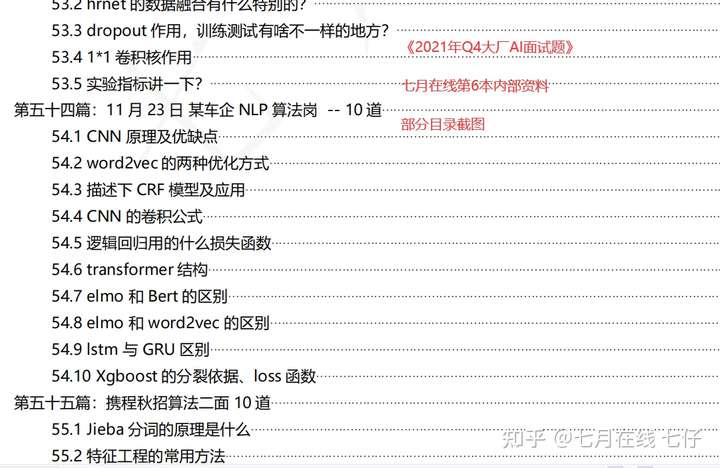





 浙公网安备 33010602011771号
浙公网安备 33010602011771号